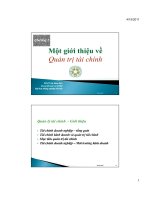ĐÁP ÁN SÁCH QUẢN TRỊ TÀI CHÍNH CUỐN TO DÀY uel KINH TE LUAT 13
Bạn đang xem bản rút gọn của tài liệu. Xem và tải ngay bản đầy đủ của tài liệu tại đây (209.42 KB, 13 trang )
Chapter 13
Real Options and Other Topics in Capital
Budgeting
Learning Objectives
After reading this chapter, the student should be able to:
Explain why conventional NPV analysis may not capture a project’s impact on the firm’s
opportunities.
Identify five different types of real options.
Explain what an abandonment/shutdown option is, give an example of a project that
includes this type of option, and explain what an option value is.
Explain what a decision tree is and provide an example of one.
Explain what an investment timing option is, and give an example of a project that
includes one.
Explain what a growth option is, and give an example of a project that includes one.
Explain what a flexibility option is, and give an example of a project that includes one.
Use the replacement chain and equivalent annual annuity methods to compare projects
with unequal lives, and explain when you might use one method over the other.
List the steps a firm goes through when establishing its optimal capital budget in practice.
Chapter 13: Real Options
Learning Objectives
85
Lecture Suggestions
This chapter covers some important but relatively technical topics. Note too that this chapter
is more modular than most, i.e., the major sections are discrete, hence they can be omitted
without loss of continuity. Therefore, if you are experiencing a time crunch, you could skip
sections or even the entire chapter.
What we cover, and the way we cover it, can be seen by scanning the slides and
Integrated Case solution for Chapter 13, which appears at the end of this chapter solution. For
other suggestions about the lecture, please see the “Lecture Suggestions” in Chapter 2, where
we describe how we conduct our classes.
DAYS ON CHAPTER: 2 OF 58 DAYS (50-MINUTE PERIODS)
86
Lecture Suggestions
Chapter 13: Real Options
Answers to End-of-Chapter Questions
13-1
a. An abandonment option is the option to abandoning a project if operating cash
flows turn out to be lower than expected. This option can both raise expected
profitability and lower project risk, because in the case of poor cash flows, the
project can be ended and rather than continue realizing negative cash flows, fixed
assets are sold and some cash is recovered.
b. An investment timing option occurs when a firm has the option of delaying the start
of a project until additional information can be obtained. After the delay, if
conditions for the project look unfavorable, the project will not be undertaken, while
if conditions are favorable then the project proceeds as usual. However, there are
some drawbacks to relying on investment timing options. First, the timing option
should raise NPV because the probability of bad returns is less, but that NPV needs
to be discounted back one additional year. Second, there might be valuable first
mover advantages to a project that will be lost if the project is delayed a year.
c. Growth options exist if an investment creates the opportunity to make other
potentially profitable investments that would not otherwise be possible. A common
example of a growth option occurs when a firm starts a project in a new country or
market. While the project is hoped to add value from its cash flows, it also has
value because it opens the door to the firm to operate in the new country/market.
d. Flexibility options permit the firm to alter operations depending on how conditions
change during the project’s life. Typically, inputs, outputs, or both can be changed
easily to respond to market demands. For example, instead of building an auto
factory that builds a specific type of car (compact, SUV, etc.), a manufacturer can
build a factory that allows the building of many types of cars. Therefore, as market
demand and consumer tastes change the firm can rapidly respond.
13-2
Failure to recognize a growth option implies that a project with a negative conventional
NPV was rejected despite have an embedded growth option whose consideration would
cause the NPV to be positive. As a result, failure to recognize the value of a growth
option implies that the capital budget is below the optimal level since a value-adding
project (albeit because of a real option) has been rejected. This argument holds when
considering failure to recognize all real options.
13-3
It might be necessary for the firm to arrange things so that it has the possibility of
abandonment when it is making the initial decision. This might require contractual
arrangements with suppliers, customers, and its union, and there might be some costs
to getting the advanced permissions. Any such costs could be compared with the
value of the option as we calculated it, and this could enter into the initial decision. In
the case of investment timing options, the initial investment might grow if the project
is delayed. For any type of options, these additional costs must be considered in the
analysis and the benefits of the “real option” must outweigh the associated costs.
13-4
The replacement chain approach is a method of comparing projects with unequal lives
that assumes that each project can be repeated as many times as necessary to reach a
Chapter 13: Real Options
Answers and Solutions
87
common life span. As such, the NPVs over this life span are then compared, and the
project with the higher common-life NPV is chosen.
13-5
The equivalent annual annuity method calculates the annual payments a project would
provide if it were an annuity. When comparing projects of unequal lives, the one with
the higher equivalent annual annuity should be chosen.
13-6
Generally, the failure to employ replacement chain analysis or the equivalent annual
annuity approach in such situations will bias the NPV against the shorter project
because it “gets no credit” for profits beyond its initial life, even though it could
possibly be “renewed” and thus provide additional NPV.
13-7
For large, mature firms with good track records we can assume that all of its profitable
projects can be financed, but this assumption is harder to make for smaller firms, new
firms, and firms with dubious track records may have difficulties raising capital, even
for projects that the firm concludes would have positive NPVs. In such circumstances,
the size of the firm’s capital budget may be constrained, a situation called capital
rationing. In such situations capital is limited, so it should be used in the most efficient
way possible. Procedures have been explored for allocating capital so as to maximize
the firm’s aggregate NPV subject to the constraint that the capital rationing ceiling is
not exceeded. As a result the greater the capital budget, the greater the need for
external financing, which raises the WACC.
13-8
Capital rationing is a situation where a firm can raise only a specified, limited amount
of capital regardless of how many good projects it has. As a result, the firm must find
the most efficient way of deploying that capital to its projects.
88
Answers and Solutions
Chapter 13: Real Options
Solutions to End-of-Chapter Problems
13-1
a. WACC = 11%; cash flows shown in millions.
0
50% Prob.
-9
50% Prob.
1
|
6
2
|
6
3
|
6
|
1
|
1
|
1
NPV @ Yr. 0
$5.662
-6.556
Expected NPV = 0.5($5.662) + 0.5(-$6.556) = -$0.447 million.
b. If the project is hugely successful, $10 million will be spent at the end of Year 2, and
the new venture will be sold for $20 million at the end of Year 3.
0
50% Prob.
1
|
6
-9
|
1
50% Prob.
2
|
6
-10
-4
|
1
3
|
6
+20
26
|
1
NPV @ Yr. 0
$12.170
-6.556
Expected NPV = 0.5($12.170) + 0.5(-$6.556) = $2.807 million.
c. Value of growth option:
NPV with option
NPV without option
13-2
a. Project A:
0 10%
|
-10,000
$2.807 million
- 0.447 million
+$3.254 million
1
|
6,000
2
|
8,000
Using a financial calculator, input the following data: CF 0 = -10000, CF1 = 6000,
CF2 = 8000, I/YR = 10, and then solve for NPVA = $2,066.12.
Project B:
0 10%
|
-10,000
1
|
4,000
2
|
4,000
3
|
4,000
4
|
4,000
Using a financial calculator, input the following data: CF 0 = -10000, CF1-4 = 4000,
I/YR = 10, and then solve for NPVB = $2,679.46.
Since neither project can be repeated, Project B should be selected because it has a
higher NPV than Project A.
b. To determine the answer to part b, we use the replacement chain (common life)
approach to calculate the extended NPV for Project A. Project B already extends out
to 4 years, so its NPV is $2,679.46.
Chapter 13: Real Options
Answers and Solutions
89
Project A:
0 10%
|
-10,000
1
|
6,000
2
|
8,000
-10,000
-2,000
3
|
6,000
4
|
8,000
Using a financial calculator, input the following data: CF 0 = -10000, CF1 = 6000,
CF2 = -2000, CF3 = 6000, CF4 = 8000, I/YR = 10, and then solve for NPV A =
$3,773.65.
Since Project A’s extended NPV = $3,773.65, it should be selected over Project B
with an NPV = $2,679.46.
c. From part a, NPVA = $2,066.12 and NPVB = $2,679.46. Solving for PMT determines
the EAA:
Project A: N = 2, I/YR = 10, PV = -2066.12, FV = 0; solve for PMT = $1,190.48.
Project B: N = 4, I/YR = 10, PV = -2679.46, FV = 0; solve for PMT = $845.29.
Project A should be selected.
13-3
0
14%
|
-190,000
1
2
3
|
87,000
|
87,000
|
87,000
Using a financial calculator, input the following data: CF 0 = -190000; CF1-3 = 87000;
I/YR = 14; and solve for NPV190-3 = $11,982 (for 3 years).
Extended NPV190-3 = $11,982 + $11,982/(1.14)3 = $20,070.
0
14%
|
-360,000
1
2
3
4
5
6
|
98,300
|
98,300
|
98,300
|
98,300
|
98,300
|
98,300
Using a financial calculator, input the following data: CF 0 = -360000; CF1-6 = 98300;
I/YR = 14; and solve for NPV360-6 = $22,256 (for 6 years).
Both new machines have positive NPVs; hence the old machine should be replaced.
Further, since its NPV is greater, choose Model 360-6.
13-4
First, solve for each project’s NPV.
Project A: CF0 = -20000, CF1 = 6000, Nj = 6, I/YR = 10; solve for NPV = $6,131.56.
Project B: CF0 = -12000, CF1 = 6000, Nj = 3, I/YR = 10; solve for NPV = $2,921.11.
The appropriate EAAs are:
Project A: N = 6, I/YR = 10, PV = -6131.56, FV = 0; solve for PMT = $1,407.85.
Project B: N = 3, I/YR = 10, PV = -2921.11, FV = 0; solve for PMT = $1,174.62.
90
Answers and Solutions
Chapter 13: Real Options
Choose Project A, whose EAA = $1,407.85
13-5
The firm should accept Projects A, B, C, and D. The firm’s optimal capital budget is
$3,900,000 at a WACC of 10.8% and it requires the firm to issue new common stock.
13-6
Since Plane A’s renewal investment changes the EAA method cannot be used, so the
replacement chain method must be used.
Plane A: Expected life = 5 years; cost = $100 million; NCF = $30 million; WACC =
12%; cost of renewing Plane A = $105 million.
A:
|
0 12%
|
-100
1
2
3
4
5
6
7
8
9
10
|
30
|
30
|
30
|
30
|
30
-105
-75
|
30
|
30
|
30
|
30
30
Enter these values into the cash flow register: CF 0 = -100; CF1-4 = 30; CF5 = -75; CF6-10
= 30. Then enter I/YR = 12, and press the NPV key to get NPVA = $9.93 million.
Plane B: Expected life = 10 years; cost = $132 million; NCF = $25 million; WACC =
12%.
B:
|
0 12%
|
-132
1
2
3
4
5
6
7
8
9
10
|
25
|
25
|
25
|
25
|
25
|
25
|
25
|
25
|
25
25
Enter these cash flows into the cash flow register, along with the interest rate, and press
the NPV key to get NPVB = $9.256 ≈ $9.26 million.
Project A is the better project and will increase the company's value by $9.93 million.
13-7
A:
|
0 10%
|
-10
1
2
3
4
5
|
4
|
4
|
4
|
4
-12
-8
|
4.2
6
7
8
|
4.2
4.2
|
4.2
Since Machine A’s renewal investment and cash flows change the EAA method cannot
be used, so the replacement chain method must be used. Machine A’s simple NPV is
calculated as follows: Enter CF0 = -10 and CF1-4 = 4. Then enter I/YR = 10, and press
the NPV key to get NPVA = $2.679 million. However, this does not consider the fact
that the project can be repeated again. Enter these values into the cash flow register:
CF0 = -10; CF1-3 = 4; CF4 = -8; CF5-8 = 4.2. Then enter I/YR = 10, and press the NPV key
to get extended NPVA = $3.58 million.
B:
0 10%
1
2
Chapter 13: Real Options
3
4
5
6
7
8
Answers and Solutions
91
|
|
|
-15
|
3.5
|
3.5
|
3.5
|
3.5
|
3.5
3.5
3.5
|
3.5
Enter these cash flows into the cash flow register, along with the interest rate, and
press the NPV key to get NPVB = $3.672 ≈ $3.67 million.
Machine B is the better project and will increase the company's value by $3.67 million,
rather than the $3.58 million created by Machine A.
13-8
First, solve for each project’s NPV.
Project X: CF0 = -100000, CF1 = 30000, CF2 = 50000, CF3 = 70000, I/YR = 12; solve for
NPV = $16,470.0255.
Project Y: CF0 = -70000, CF1 = 30000, Nj = 4, CF2 = 10000, I/YR = 12; solve for NPV =
$26,794.749.
The appropriate EAAs are:
Project X: N = 3, I/YR = 12, PV = -16470.0255, FV = 0; solve for PMT = $6,857.28.
Project Y: N = 5, I/YR = 12, PV = -26794.749, FV = 0; solve for PMT = $7,433.12.
Choose Project Y.
13-9
Cash flows shown in millions on time line:
0
|
10%
-20
1
2
3
7.5
7.5
7.5
|
|
|
NPV = -$1.349 million.
Wait 1 year; cash flows shown in millions on time line:
Strong demand
50% Prob.
0
|
0
Weak demand
50% Prob.
|
0
10%
1
|
-20
2
|
10
3
|
10
4
|
10
|
-20
|
5
|
5
|
5
NPV @ Yr. 0
$4.426
-6.878
However, if demand is weak, the project’s NPV is negative and therefore would not be
undertaken. The value of this option of waiting one year is evaluated as 0.5($0) +
(0.5)($4.426) = $2.213 million. Since the NPV of waiting one year is greater than going
ahead and proceeding with the project today and greater than zero, it makes sense to
wait.
13-10 a. NPV of abandonment after Year t:
Using a financial calculator, input the following: CF 0 = -22500, CF1 = 23750, and
I/YR = 10 to solve for NPV1 = -$909.09 ≈ -$909.
92
Answers and Solutions
Chapter 13: Real Options
Using a financial calculator, input the following: CF0 = -22500, CF1 = 6250, CF2 =
20250, and I/YR = 10 to solve for NPV2 = -$82.64 ≈ -$83.
Using a financial calculator, input the following: CF 0 = -22500, CF1 = 6250, Nj = 2,
CF3 = 17250, and I/YR = 10 to solve for NPV3 = $1,307.29 ≈ $1,307.
Using a financial calculator, input the following: CF 0 = -22500, CF1 = 6250, Nj = 3,
CF4 = 11250, and I/YR = 10 to solve for NPV4 = $726.73 ≈ $727.
Using a financial calculator, input the following: CF 0 = -22500, CF1 = 6250, Nj = 5,
and I/YR = 10 to solve for NPV5 = $1,192.42 ≈ $1,192.
The firm should operate the truck for 3 years, NPV3 = $1,307.
b. No. Abandonment possibilities could only raise NPV and IRR. The value of the firm
is maximized by abandoning the project after Year 3.
13-11 a. WACC1 = 12%; WACC2 = 12.5%.
Since each project is independent and of average risk, all projects whose IRR > WACC
will be accepted. Consequently, Projects A, B, C, D, and E will be accepted and the
optimal capital budget is $5,250,000. After accepting projects A, B, and C, all of
retained earnings will be used up and additional equity will be raised to fund the
remaining projects, whose WACCs all exceed 12.5%.
b. If Projects C and D are mutually exclusive, the firm will select Project D, because its
NPV is greater than Project C’s NPV. So, the optimal capital budget is $4 million,
and consists of Projects A, B, D, and E.
c. The appropriate costs of capital are 10.5% for low-risk projects, 12.5% for averagerisk projects, and 14.5% for high-risk projects. Since Project A is high risk, it will be
rejected (14% < 14.5%). Projects B, C, D, and E are all average risk and will be
accepted since their returns exceed 12.5%. Projects F and G are low risk and will
both be accepted since their returns exceed 10.5%. Therefore, the optimal capital
budget is $6 million and consists of Projects B, C, D, E, F, and G.
13-12 a.
0
|
10%
|
-8
1
2
3
4
4
4
4
4
|
|
|
NPV = $4.6795 million.
b. Wait 2 years:
10% Prob.
0
|
0
90% Prob.
|
0
10%
Chapter 13: Real Options
1
|
0
2
|
-9
3
|
2.2
4
|
2.2
5
|
2.2
6
|
2.2
|
0
|
-9
|
4.2
|
4.2
|
4.2
|
4.2
NPV @ Yr. 0
-$1.6746
3.5648
Answers and Solutions
93
If the cash flows are only $2.2 million, the NPV of the project is negative and, thus,
would not be undertaken. The value of the option of waiting two years is evaluated
as 0.10($0) + 0.90($3.5648) = $3.2083 million.
Since the NPV of waiting two years is less than going ahead and proceeding with
the project today, it makes sense to drill today.
c. The investment timing option has a value of $0. Since the difference between the
project with the option and the project without the option is negative, $3.2083
million – $4.6795 million = -$1.4712 million, the option will not be exercised. In
other words, the costs of delaying the project outweigh the benefits gained by
delaying and gathering more information.
d. There is a danger that oil prices will decline causing the company to receive less
revenue for the oil it extracts, and there is a danger that the company will lose
market share or the chance to compete for new contracts as a result of waiting.
13-13 a. Cash flows if tax imposed:
0 12%
1
|
|
-6,200,000 600,000
•••
14
|
600,000
15
|
600,000
Using a financial calculator, input the following data: CF 0 = -6200000; CF1-15 = 600000;
I/YR = 12; and then solve for NPV = -$2,113,481.31.
b. Cash flows if tax not imposed:
0 12%
1
|
|
-6,200,000 1,200,000
•••
14
15
|
|
1,200,000 1,200,000
Using a financial calculator, input the following data: CF 0 = -6200000; CF1-15 =
1200000; I/YR = 12; and then solve for NPV = $1,973,037.39.
c. If they proceed with the project today, the project’s expected NPV = (0.5 × $2,113,481.31) + (0.5 × $1,973,037.39) = -$70,221.96. So, Nevada Enterprises
would not do it.
d. Since the project’s NPV with the tax is negative, if the tax were imposed the firm
would abandon the project. Thus, the decision tree looks like this:
0
1
12%
50% Prob.
|
|
Taxes
-6,200,000 6,600,000
No Taxes
|
50% Prob. -6,200,000
|
1,200,000
2
|
0
|
1,200,000
•••
15
|
0
NPV @ Yr. 0
-$ 307,142.86
•••
|
1,200,000
1,973,037.39
Expected NPV $ 832,947.27
Yes, the existence of the abandonment option changes the expected NPV of the
project from negative to positive. Given this option the firm would take on the
project because its expected NPV is $832,947.27.
94
Answers and Solutions
Chapter 13: Real Options
e.
50% Prob.
Taxes
0
1
12%
|
|
NPV = ? -1,500,000
wouldn’t do
+300,000 = NPV @ t = 1
No Taxes
50% Prob.
|
NPV = ?
|
-1,500,000
+4,000,000 = NPV @ t = 1
NPV @ Yr. 0
$
0.00
2,232,142.86
Expected NPV $1,116,071.43
If the firm pays $1,116,071.43 for the option to purchase the land, then the NPV of
the project is exactly equal to zero. So the firm would not pay any more than this
for the option.
Chapter 13: Real Options
Answers and Solutions
95
Comprehensive/Spreadsheet Problems
Note to Instructors:
The solutions to these problems are not provided to students at the back of their
text. Instructors can access the Excel files on the textbook’s Web site or the
Instructor’s Resource CD.
13-14 See Problem 13-13 on the preceding two pages.
13-15 a. Without abandonment (Cost @ t = 0 = -$10 million):
1
|
9.0
2
|
9.0
3
|
9.0
40% Prob
Average
|
4.5
|
4.5
|
4.5
0.81
30% Prob
Bad
-1.5
|
-1.5
|
-1.5
-13.60
30% Prob.
Good
12%
NPV @ Yr. 0
$11.62
Exp NPV = 0.3($11.62) + 0.4($0.81) + 0.3(-$13.60) = -$0.27 million.
Standard deviation = $9.81 million.
With abandonment (Cost @ t = 0 = -$10 million):
After the first year, the fixed assets will be depreciated by 1/3 of their value,
meaning they are worth $6.67 million and can be retired/sold for $6.00 million. The
cash flow in the abandonment branch reflects the -$1.5 million operating cash flow
plus the retirement of fixed assets (-$1.5 million + $6 million).
1
|
9.0
2
|
9.0
3
|
9.0
40% Prob
Average
|
4.5
|
4.5
|
4.5
30% Prob
Bad
|
4.5
|
|
30% Prob.
Good
12%
NPV @ Yr. 0
$11.62
0.81
-5.98
Exp NPV = 0.3($11.62) + 0.4($0.81) + 0.3(-$5.98) = $2.01 million.
Standard deviation = $6.89 million.
When the abandonment option is factored in, the very large negative NPV under
bad conditions is reduced, and the expected NPV becomes positive. Also, the
standard deviation and CV decline, indicating that the abandonment option lowers
the project’s risk.
b. NPV declines as the WACC increases, and it increases as the percentage of book at
which the asset can be sold increases. However, if the WACC is reasonably close to
96
Integrated Case
Chapter 13: Real Options
the estimated 12%, and the sale percentage is close to the estimated 90%, then the
NPV will be comfortably positive.
Conclusion: When abandonment is recognized, the project is acceptable.
c. Without abandonment, with growth (Cost @ t = 0 = -$10 million)
1
|
9.0
2
|
9.0
3
|
20.6
40% Prob
Average
|
4.5
|
4.5
|
4.5
0.81
30% Prob
Bad
-1.5
|
-1.5
|
-1.5
-13.60
30% Prob.
Good
12%
NPV @ Yr. 0
$19.88
Exp NPV = 0.3($19.88) + 0.4($0.81) + 0.3(-$13.60) = $2.21 million.
Standard deviation = $13.02 million.
This growth option makes the project’s NPV positive, too. Using a spreadsheet, the
WACC at which NPV equals zero in this case is 23.11%. So, we can be safe in
saying that this project’s NPV is robust to changes in the WACC.
d. Without abandonment, with investment timing (Cost @ t = 0 = -$10 million)
2
|
9.0
3
|
9.0
4
|
9.0
40% Prob
Average
|
4.5
|
4.5
|
4.5
0.81
30% Prob
Bad
0
|
0
|
0
0
30% Prob.
Good
12%
NPV @Yr. 1
$11.62
Exp NPV @ Year 1 = 0.3($11.62) + 0.4($0.81) + 0.3(0) = $3.81 million.
Expected NPV today = $3.81/1.12 = $3.40 million.
Considering the project originally had a -$0.27 million NPV, the investment timing
option adds $3.67 million of value to the project.
Chapter 13: Real Options
Integrated Case
97









